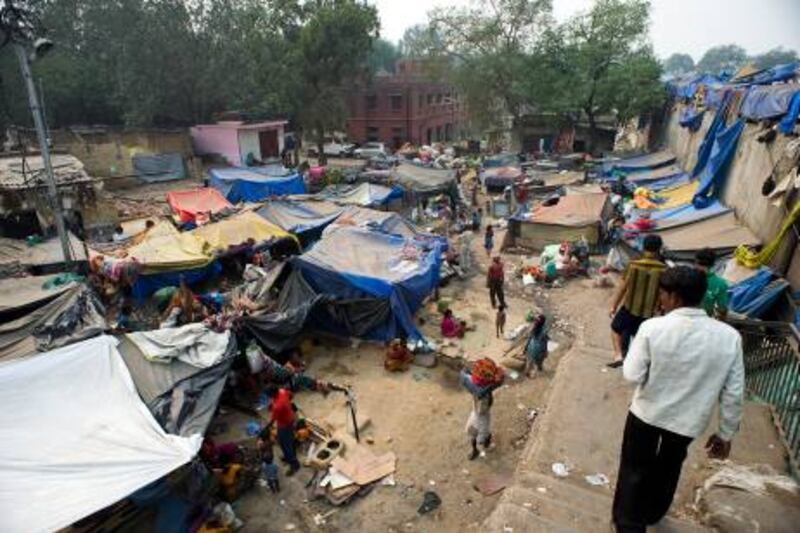NEW DELHI // India's population hit 1.21 billion last year, having grown 17 per cent over the past decade. There are now 50 Indian children born every minute.
At the same time the population is on the move, as millions abandon the struggling farm sector in search of jobs in the towns and cities.
A recent report by the consultancy McKinsey estimated India will add at least 10 million people a year to its urban areas.
But the almost complete absence of urban planning means most of them end up in places such as Baljeet Nagar, a sprawling mass of single-room shacks spread over a hillside in the centre of Delhi.
Thirty years ago, there were only a few dozen families at this site. Today, it is home to about 15,000 people, who struggle to maintain their dignity with little support from the government.
"A water tanker comes once every eight days," said Ram Pal Singh, 50, a mechanic. "They built some toilets last year but they soon broke and were taken away again."
Drifting through the air is the stench of rubbish from a giant dump at the entrance. Naked children play in the dirt. Almost every family has young children.
But rather than help these families, the authorities seem determined to drive them out.
"The bulldozers arrived in the morning when the men had gone off to work," said Aarushi Singh, 34, who works part-time as a domestic servant.
"When I saw them demolishing my home I fell unconscious and they had to take me to hospital. All my belongings were destroyed."
This attempted eviction took place in December 2009 and was only stopped after a local charity gained an emergency halt order from the high court. The case is still being fought to save the homes, but 33 other slums have been marked for demolition in the capital.
"These people are treated worse than refugees," said Miloon Kothari, a UN special rapporteur on the right to adequate housing, based in Delhi.
"They have been forced to come here by the conditions in the countryside but when they arrive there is no place to go to ask for a place to live."
All of the families in Baljeet Nagar are migrants from impoverished rural communities in northern India who have come to work as labourers, servants and drivers.
The reason for the eviction at Baljeet Nagar was ostensibly a "beautification" drive before last year's Commonwealth Games, although previous experience shows it may have had more to do with the value of land.
When a slum was destroyed in Chanakyapuri in 2007, leaving 90 per cent of its residents homeless, it became the site for the US$150 million (Dh550.9m) Leela Palace New Delhi hotel.
"Development in the cities is driven by the real estate sector," said Dunu Roy, the director of the Hazards Centre in Delhi, which campaigns on housing and homeless issues.
"We are seeing the opposite of what happened in the West, where the rich gradually moved to the suburbs. Here, it is the poor that are being forced out in favour of these huge luxury developments.
"But there is no work on the periphery of the city."
A child born today in India has a 50-50 chance of being malnourished during their infancy, and a 5 per cent chance of dying before their fifth birthday.
Education rates are improving but a recent Harvard study found only 4 per cent of children finish secondary school in India.
Having reached employment age, there is a less than 10 per cent hope of finding a regular taxpaying job with any welfare benefits or security.
"Planning in this country is only ever about big infrastructure," said Mr Kothari. "It is never for social housing, education or health. There is a real crisis of organisation."
In June, the government announced an ambitious scheme aimed at providing houses to 32 million slum dwellers, by bearing half of the cost of cheap housing projects and promising to act as guarantor for housing loans to the poor.
But frequent plans to manage urbanisation have been tried in the past and achieved little.
"Unless you have a parallel process of controlling investment in to high-end projects, you can have as many social housing programmes as you want but they won't get built," said Mr Kothari.






